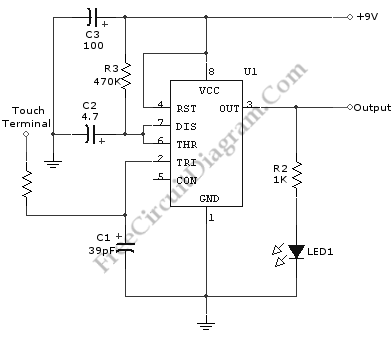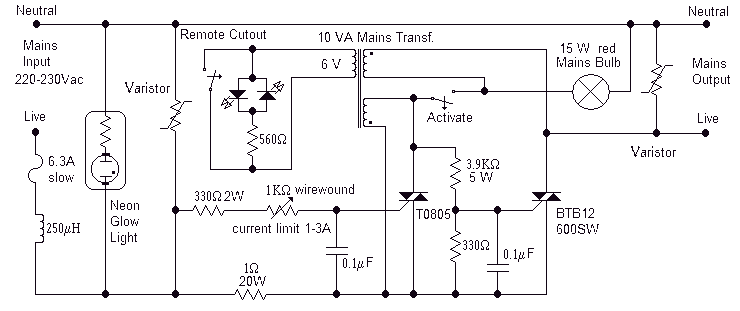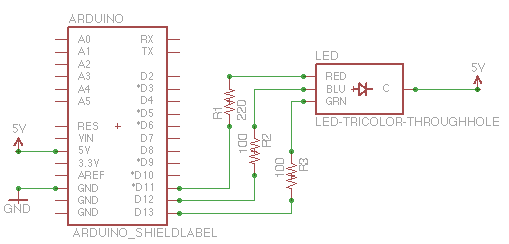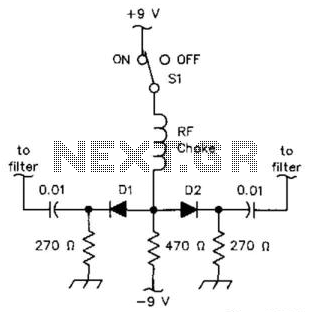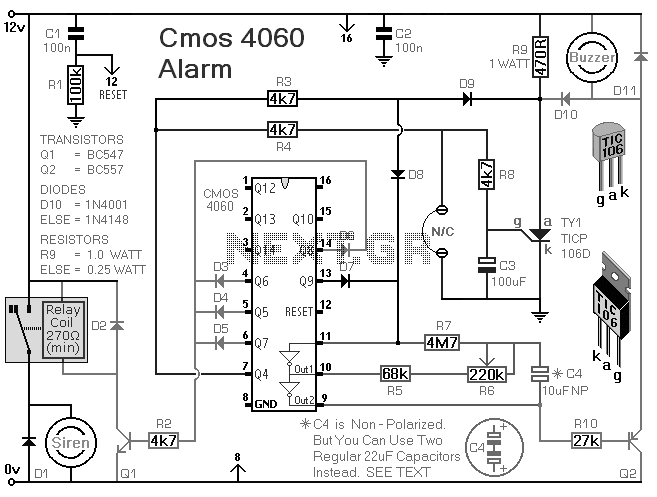
Electronic Touch Switch
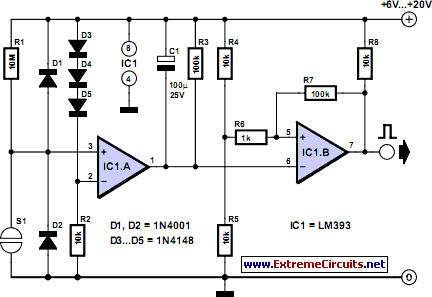
Mechanical contacts have the disadvantage of wearing out. Therefore, it is practical to use an electronic touch switch in certain situations. This type of touch switch utilizes the resistance of human skin for its switching action. The schematic illustrates a circuit that senses skin resistance and converts it into a useful switching signal. The touch switch contacts can be constructed from two small metal plates, rivets, nails, etc., positioned close together on a non-conductive surface. In this circuit, a comparator of the type LM393 is employed. In the idle state, a voltage equal to the power supply voltage is present on the non-inverting input of IC1a via resistor R1. The inverting input of IC1a is set to the supply voltage minus 1.8 V through resistors R2 and diodes D3 to D5, resulting in the open-collector output of IC1a being equal to the power supply voltage through resistor R3. This voltage is inverted by IC1b. The voltage at the non-inverting input of IC1b, determined by voltage divider resistors R4 and R5, is half the power supply voltage and lower than the voltage on the inverting input, causing the output of IC1b to be 0. When a finger bridges the two touch contacts, the voltage at the non-inverting input decreases sufficiently to toggle the comparator state. The moisture of the skin results in a resistance of 1 to 10 MΩ. If the circuit is used near equipment connected to the mains, touching only the upper contact can operate the switch, provided the circuit is earthed. The body acts as an antenna, receiving the 50 Hz (or 60 Hz) from the mains, which can toggle IC1a at the same frequency. Capacitor C1 and resistor R3 prevent this 50 Hz signal from reaching the input of IC1b and provide a usable pulse of approximately 10 seconds at the output of IC1b. It is noteworthy that even a fly walking across the touch switch can generate a switching signal, indicating that this circuit should not be used to control critical systems such as heating or garage doors. Additionally, the wires connecting the touch contacts to the circuit should not be excessively long to avoid interference. The power supply voltage for the circuit is not critical; any regulated DC voltage between 6 to 20 V can be utilized.
The electronic touch switch described utilizes the LM393 comparator to effectively convert the resistance change due to skin contact into a digital signal. The circuit operates on the principle that the human body can act as a conductive path when a finger touches the contact plates. The design employs a voltage divider and a series of diodes to create a stable reference voltage, ensuring reliable operation. The output of the circuit is designed to toggle state based on the input from the touch contacts, allowing for a responsive switching mechanism that can be integrated into various applications.
The choice of components is critical for ensuring the touch switch's functionality. The LM393, known for its low power consumption and dual comparator design, is suitable for battery-operated applications. The resistors R1, R2, R3, R4, and R5 are selected to provide the necessary voltage thresholds for the comparators to operate correctly. The inclusion of capacitors, such as C1, helps filter out noise and prevents false triggering from ambient electrical interference, which is particularly important in environments with AC mains power.
For practical applications, the touch switch can be housed in an enclosure that minimizes exposure to environmental factors while allowing for effective touch input. The mounting of the metal plates should be done carefully to ensure they are close enough for effective sensing but not so close that they create a short circuit. The overall design emphasizes reliability, ease of use, and safety, making it suitable for a range of applications where mechanical switches may fail due to wear.Mechanical contacts have the disadvantage that they wear out. That is why it is practical to use an electronic touch switch` in some situations. With such a touch switch the resistance of the human skin is used for the switching action. The schematic shows the design of a circuit that senses the resistance of the skin and converts it into a useful switching signal. The touch switch contacts can be made from two small metal plates, rivets, nails, etcetera, which are placed close together on a non-conducting surface. In this circuit a comparator of the type LM393 has been used. In the idle state there is, via R1, a voltage equal to the power supply voltage on the non-inverting input of IC1a.
Because the inverting input of IC1a is set with R2 and D3 to D5 at the supply voltage minus 1. 8 V, the open-collector output of IC1. a is, via R3, equal to the power supply voltage. This voltage is inverted by IC1. b. The voltage at the non-inverting input of IC1. b amounts to half the power supply voltage (through voltage divider R4 and R5) and is lower than the voltage on the inverting input. The output of IC1. b is therefore a 0`. If the two touch contacts are bridged with a finger, the voltage at the non-inverting input will become low enough to cause the comparator to toggle state.
The moistness of the skin results in a resistance of 1 to 10 MR. If this circuit is used in the vicinity of equipment that`s connected to the mains, then it can be sufficient to touch only the upper contact to operate the switch, provided that the circuit has been earthed. The body then acts as an antenna which receives the 50 Hz (or 60 Hz) from the mains. This is enough to toggle IC1. a at the same 50 Hz. C1/R3 prevent this 50 Hz from reaching the input of IC1b and provide a useable pulse` of about 10 s at the output of IC1.
b. Note that a fly walking across the touch switch conducts enough to generate a switching signal. So do not operate important things with this circuit (such as the heating system or the garage door). Do not make the wires between the touch contacts and the circuit too long to prevent picking up interference.
The power supply voltage for the circuit is not very critical. Any regulated DC voltage in the range from 6 to 20 V can be used. 🔗 External reference
The electronic touch switch described utilizes the LM393 comparator to effectively convert the resistance change due to skin contact into a digital signal. The circuit operates on the principle that the human body can act as a conductive path when a finger touches the contact plates. The design employs a voltage divider and a series of diodes to create a stable reference voltage, ensuring reliable operation. The output of the circuit is designed to toggle state based on the input from the touch contacts, allowing for a responsive switching mechanism that can be integrated into various applications.
The choice of components is critical for ensuring the touch switch's functionality. The LM393, known for its low power consumption and dual comparator design, is suitable for battery-operated applications. The resistors R1, R2, R3, R4, and R5 are selected to provide the necessary voltage thresholds for the comparators to operate correctly. The inclusion of capacitors, such as C1, helps filter out noise and prevents false triggering from ambient electrical interference, which is particularly important in environments with AC mains power.
For practical applications, the touch switch can be housed in an enclosure that minimizes exposure to environmental factors while allowing for effective touch input. The mounting of the metal plates should be done carefully to ensure they are close enough for effective sensing but not so close that they create a short circuit. The overall design emphasizes reliability, ease of use, and safety, making it suitable for a range of applications where mechanical switches may fail due to wear.Mechanical contacts have the disadvantage that they wear out. That is why it is practical to use an electronic touch switch` in some situations. With such a touch switch the resistance of the human skin is used for the switching action. The schematic shows the design of a circuit that senses the resistance of the skin and converts it into a useful switching signal. The touch switch contacts can be made from two small metal plates, rivets, nails, etcetera, which are placed close together on a non-conducting surface. In this circuit a comparator of the type LM393 has been used. In the idle state there is, via R1, a voltage equal to the power supply voltage on the non-inverting input of IC1a.
Because the inverting input of IC1a is set with R2 and D3 to D5 at the supply voltage minus 1. 8 V, the open-collector output of IC1. a is, via R3, equal to the power supply voltage. This voltage is inverted by IC1. b. The voltage at the non-inverting input of IC1. b amounts to half the power supply voltage (through voltage divider R4 and R5) and is lower than the voltage on the inverting input. The output of IC1. b is therefore a 0`. If the two touch contacts are bridged with a finger, the voltage at the non-inverting input will become low enough to cause the comparator to toggle state.
The moistness of the skin results in a resistance of 1 to 10 MR. If this circuit is used in the vicinity of equipment that`s connected to the mains, then it can be sufficient to touch only the upper contact to operate the switch, provided that the circuit has been earthed. The body then acts as an antenna which receives the 50 Hz (or 60 Hz) from the mains. This is enough to toggle IC1. a at the same 50 Hz. C1/R3 prevent this 50 Hz from reaching the input of IC1b and provide a useable pulse` of about 10 s at the output of IC1.
b. Note that a fly walking across the touch switch conducts enough to generate a switching signal. So do not operate important things with this circuit (such as the heating system or the garage door). Do not make the wires between the touch contacts and the circuit too long to prevent picking up interference.
The power supply voltage for the circuit is not very critical. Any regulated DC voltage in the range from 6 to 20 V can be used. 🔗 External reference
